How often do you add items to your shopping cart and then abandon or postpone purchases on an e-commerce app? Quite often, right?
Doesn’t a well-crafted and timed push notification highlighting a price drop in any of the items that you added to cart tempt you to “buy now”?
If you land on the relevant product page, you might go ahead and instantly purchase the product. But, if you’re redirected to the app or mobile site’s home page, you might drop off completely.
When you are directly taken to the relevant product page, it is simply deep linking the push notification, encouraging app relaunch and transaction completion. And this can be the difference between a successful and an unsuccessful time-sensitive push notification campaign.
As a KPI-driven mobile marketer, deep linking is critical to your mobile marketing strategy.
What is Deep Linking?
Deep linking refers to the use of a specific URL that directs users to a particular page on a website, mobile site, or a precise location within the app.
Deep links can be done with a variety of channels, such as web links, emails, SMS, mobile push notifications, web push notifications, social media posts, search result listings, and/or banner ads.
Think of deep links as intelligent shortcuts to contextual destinations you want your users to reach in a timely manner.
Why is Deep Linking Important for Mobile Marketers?
Deep links are quite common in websites, being just the extension of the URL. For instance, http://example.com will take the user to the home page of the website, while http://example.com/path/page will take users to a particular page within the website.
In the highly competitive world of mobile apps, you need fast and efficient ways to lead your users from your personalized push notifications to specific pages within your app, making it easier for them to:
– Reconsider completing a purchase if there is an abandoned cart situation,
– Check out a new app feature, or
– Use the coupon code to exercise the deal that you might be promoting
These are just some of the common use cases that effective deep linking can address. With ever-diminishing attention spans, app users may go from an email to the mobile site, to an app, to an SMS, and back again within moments.
The easier and quicker you make it for your users to act on your marketing message, the higher the chances of app conversion.
This is where deep linking in push notifications acts as a game changer.
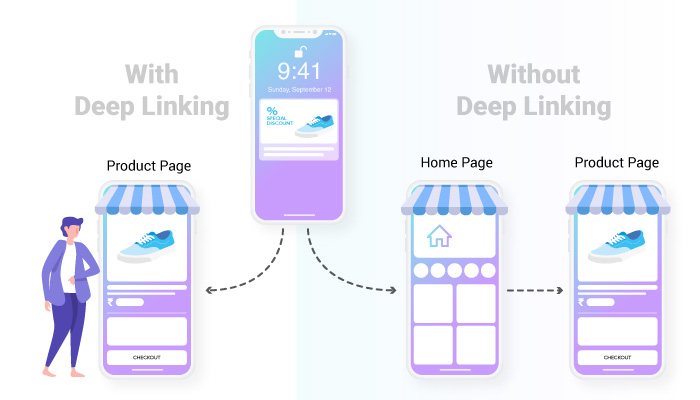
Why Should You Use Deep Linking in Push Notifications?
Push notifications are the most important and powerful tool in a mobile marketer’s toolkit. If your aim is to drive acquisition, engagement, retention, and conversion, then you cannot ignore mobile deep linking.
In fact, deep linking alone can help you elevate activation and retention rates by 2X, encouraging users to visit the app 2X as frequently versus users who hadn’t received deep-linked push notifications.
5 Benefits of Deep Linking Push Notifications
Here are the top 5 benefits of deep linking your push notifications:
1. Better App User Experience
As mentioned earlier, deep links are like shortcuts. They enable app users to access the desired content easily and quickly by simply clicking on the relevant push notification that you send them.
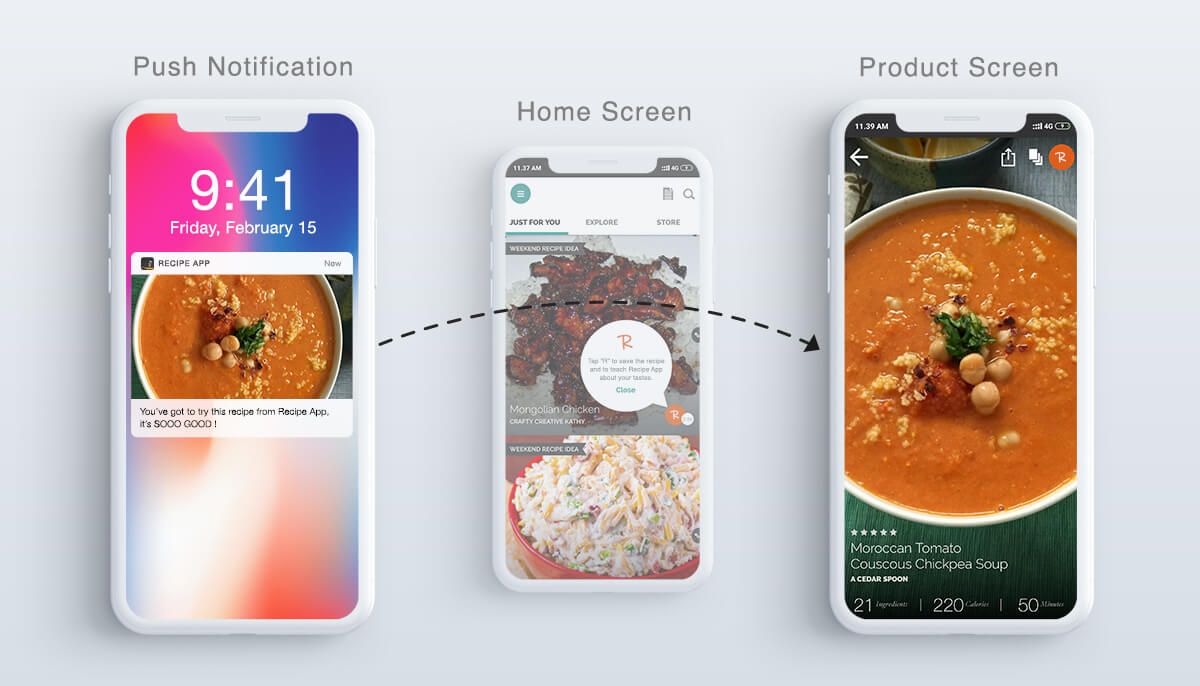
2. Faster App Conversions and Higher Revenues
Deep linking shortens the most common paths toward in-app conversions, minimizing the chances of users dropping off while trying to navigate through the app.
For apps such as e-commerce, travel, hotel booking, media OTT, music, and news, where the app content/product categories can be huge, sending the users directly to the specific product, offer, or promo page can exponentially impact the conversion rate. This, in turn, results in maximizing monetization opportunities.
For instance, in a hotel booking app’s push notification, if deep linking is enabled, the user can be directly ushered to the booking page of a specific hotel instead of the app’s home page which might overwhelm him with too many options.
This hotel recommendation can be personalized based on the user’s historical browsing and booking behaviour, budget, and location.
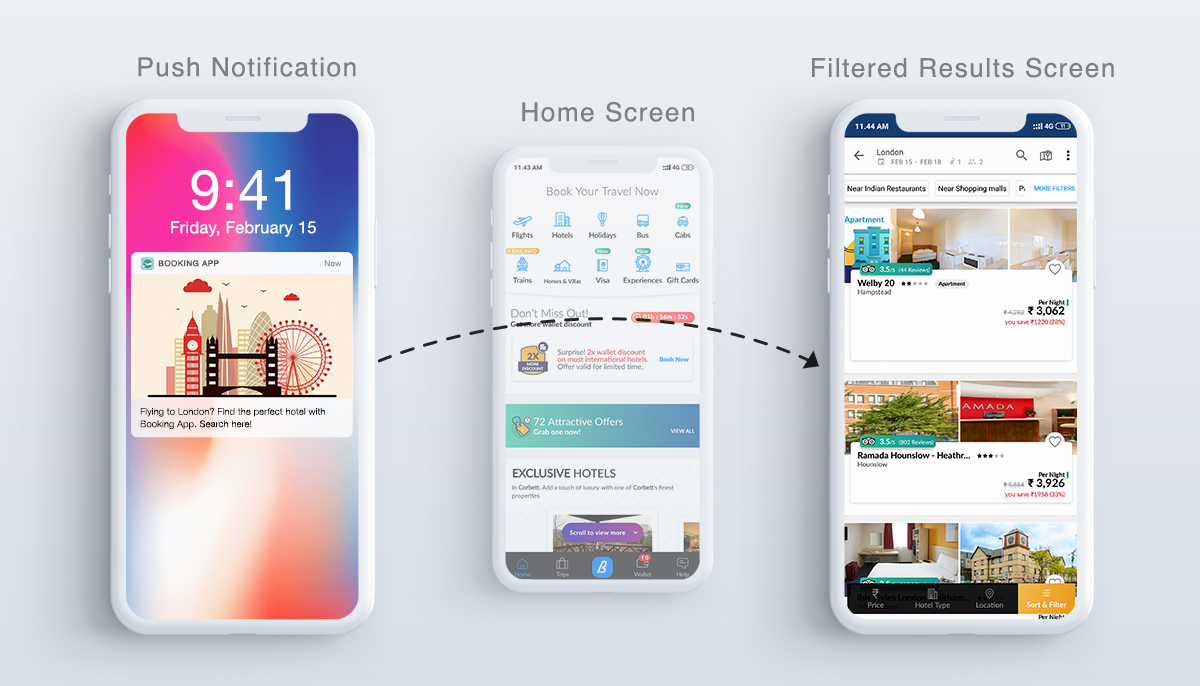
3. Better App User Re-engagement
Re-engaging dormant app users isn’t easy. While push notifications can serve as a great way to bring them back to the app, it can work only when done correctly.
Adding contextual deep links to all your re-engagement efforts can propel your inactive users engage with the most relevant page of your app (a personalized offer, free wallet points, new feature, an ongoing sale, etc.) without wasting much of their time.
Also Read: 5 Best Examples of iOS Push Notifications to Re-engage Dormant Users
4. Improved App Usage
With deep linking, you can nudge your users to explore new features as well as less-used features by pointing them directly to those specific areas within your app or mobile site.
5. Efficient Push Notification Campaign Tracking
Deep links enable you to track and measure the entire user experience and hence help you gain a better understanding of your users’ in-app behavior and campaign effectiveness.
How Does Deep Linking Work?
Deep linking has come a long way over the last few years. Initially, there were traditional deep links that worked only if the app is installed on the user’s smartphone and showed either an error or a fall-back page if the app wasn’t installed.
The more advanced deferred deep links redirect users to the specified content even if the app isn’t installed when the link is opened. The link first routes the user to the respective app store, encouraging app download. The user is then taken to the specific “deferred” content immediately on the first app launch.
Taking mobile deep linking a step further, there are contextual deep links that, along with the functionality of deferred links, have the ability to store information about where a user wants to go, where the link was clicked, who originally shared the link, and other helpful user data. Read a detailed article on types of deep linking here.
Note that it is quite important that your deep links don’t break, for they can damage the app experience. You need an efficient app development team to implement deep linking!
Read: How to implement deep linking in Android and iOS
How Can You Boost Key App Metrics by Deep Linking Push Notifications?
Here 8 tips that highlight how deep linking push notifications can help you achieve a better ROI on your mobile marketing strategy:
1. Promote specific products, offers, and flash sales
Craft highly attractive push notifications (including rich elements) and take them to the specific product category or offers page.
For instance, let’s consider an ecommerce fashion app, and you are looking to promote a 50% sale on a specific footwear brand. If the push notification communicating this sale will take your users to the home screen instead of the particular brand page, how likely is it that the users will remember the brand name and category?
Even if they do, it can turn into a bad user experience. Deep-linked push notifications will not only raise the chances of conversion but also improve the users’ entire app usage experience.
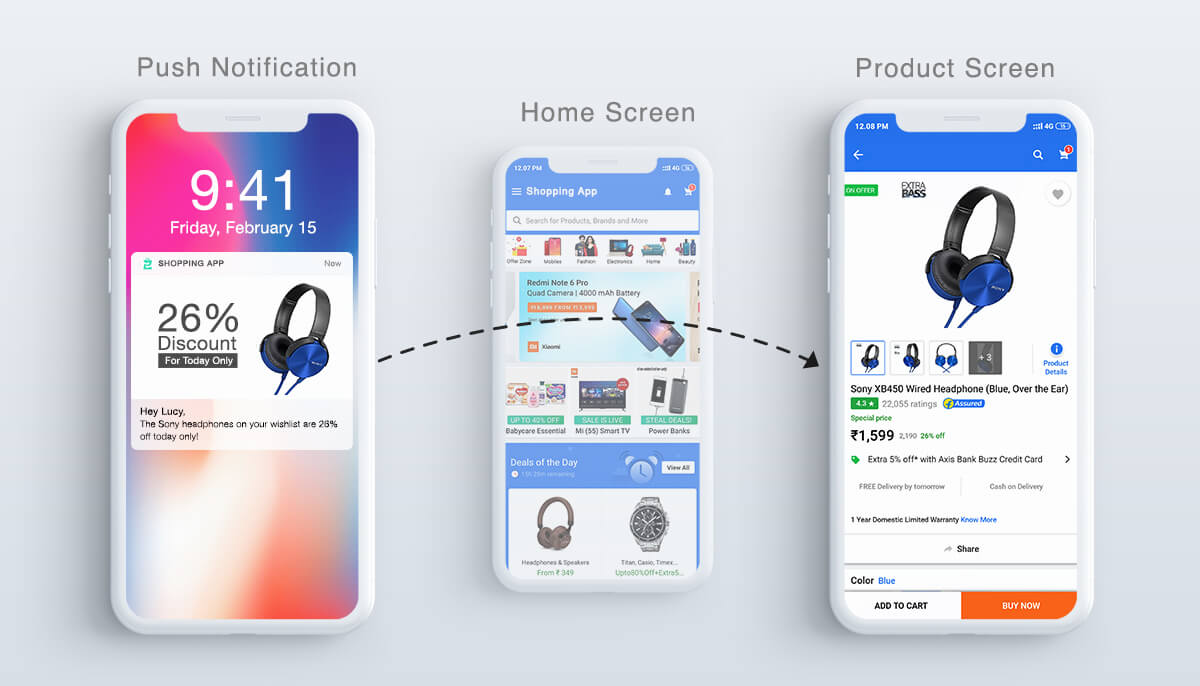
2. Announce new app features and version updates
Help your users discover, learn about, and adopt key features by deep linking your push notifications because your users might take a while or might never navigate to the feature on their own.
Also, announce app updates through notifications that take users directly to the app store, making it easy for them to update the app.
Prevent your users from the confusion that might arise by announcing a new feature and then taking them to the same old home screen.
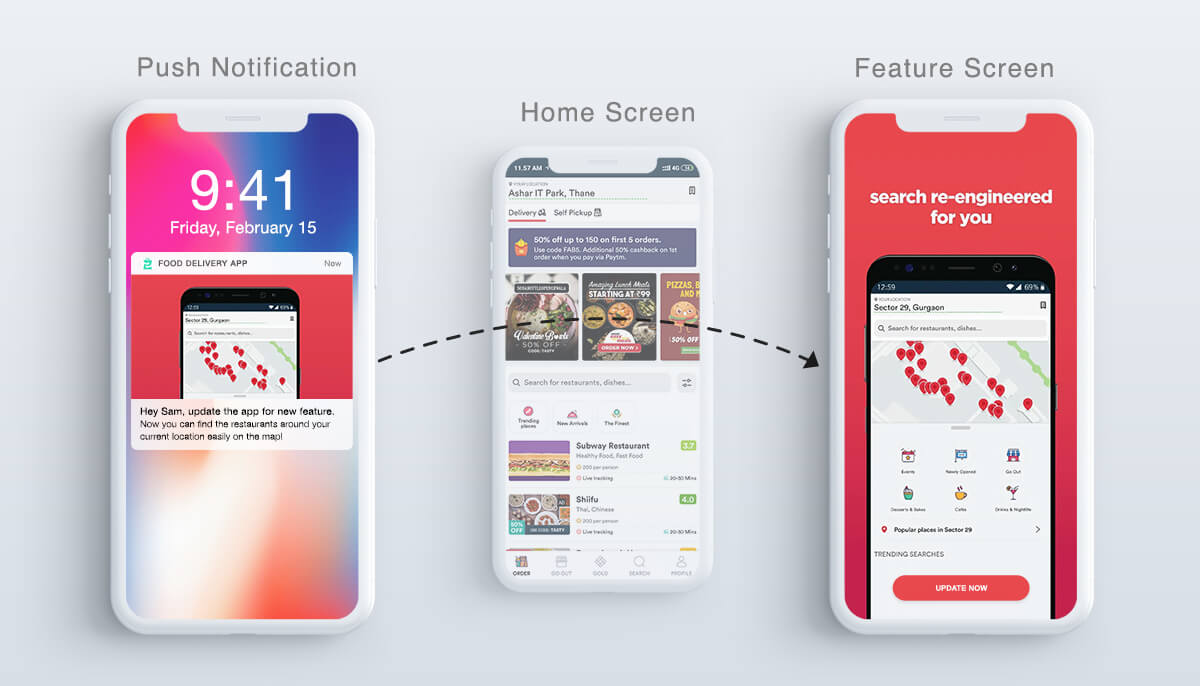
3. Share trending content
News, music, social media, and media OTT apps need to keep their users informed about the latest news, updates, and releases in real time.
Each time you receive a “Like” on your Facebook post, wouldn’t you want the push notification to redirect you to that specific post and not your newsfeed? If there is a piece of breaking news you want to share with your users, you want them to arrive at the article faster. Deep linking is the surest way to make this happen.
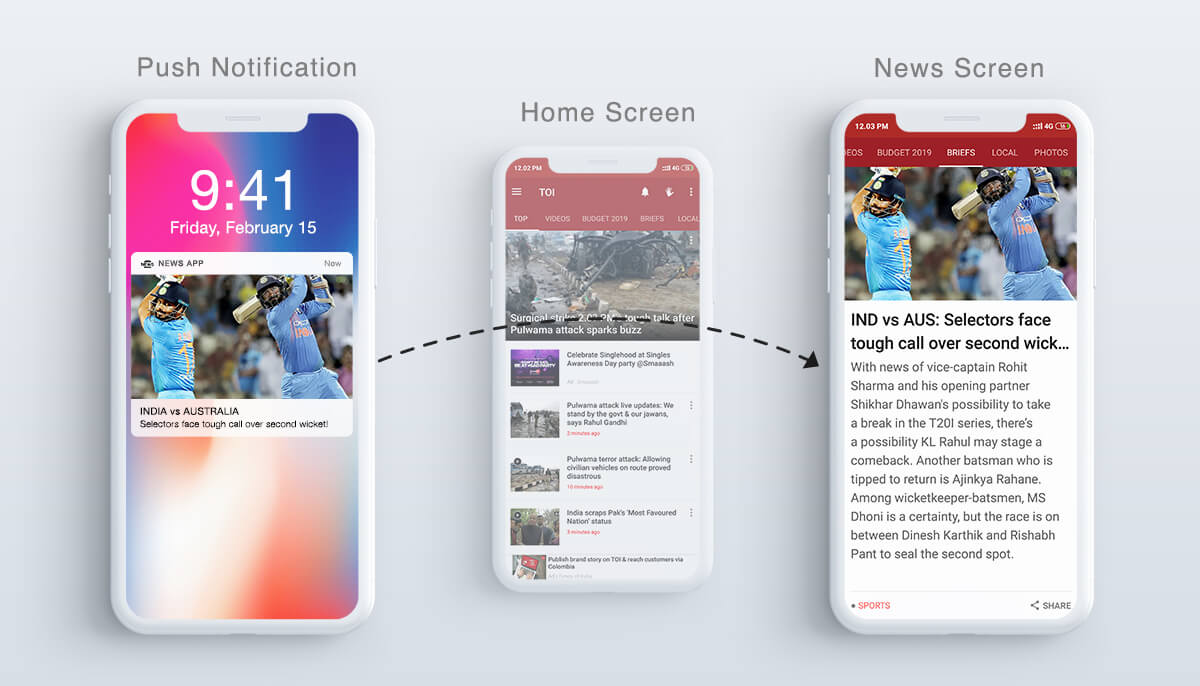
4. Encourage faster shopping cart checkouts
Re-target users who have abandoned their shopping carts with push notifications that take them directly to the transaction page.
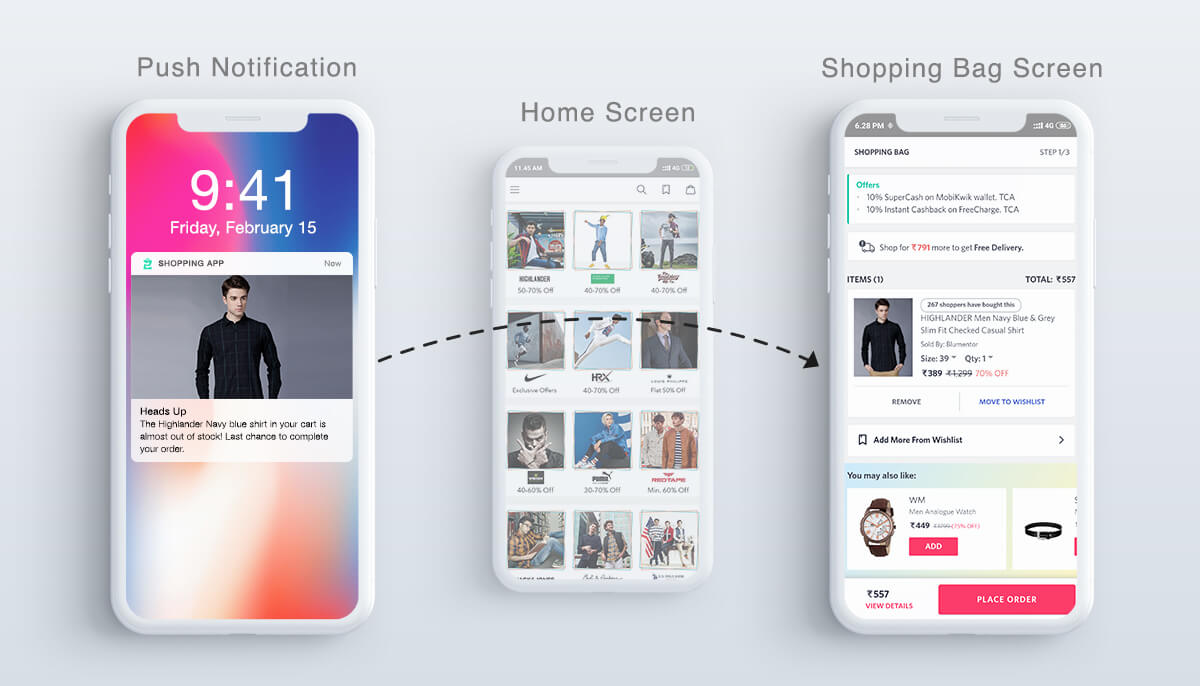
5. Enhance the app onboarding experience
Imagine you happen to be looking for some Chinese food delivery options on mobile. You installed an app, and the phone buzzed “Did you check the latest Chinese restaurant in Powai?”
You clicked, landed at the restaurant’s menu page, and placed an order! It’s possible that you might not have discovered the restaurant if you navigated the usual way. A personalized offer did create that first impression and made the first experience satisfactory and memorable.
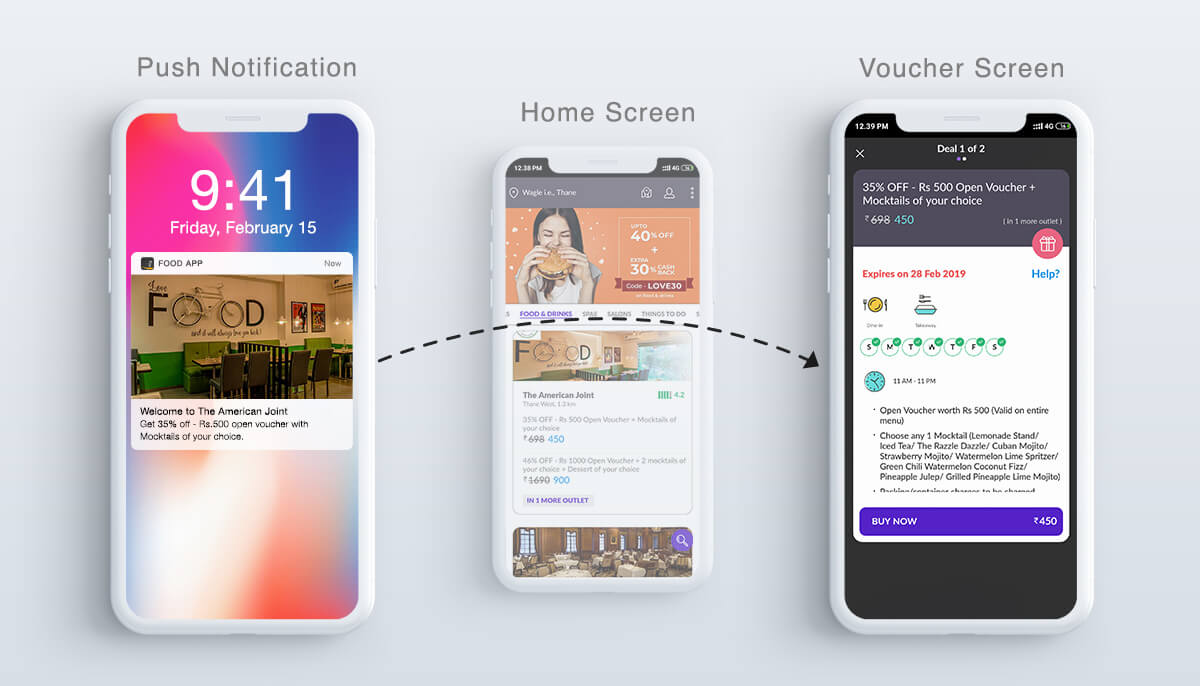
6. Send transactional messages that improve order tracking
Send notifications about delivery tracking, order status, billing, etc., through push notifications that take the user to the relevant page directly. Such push notifications make for an awesome app user experience.
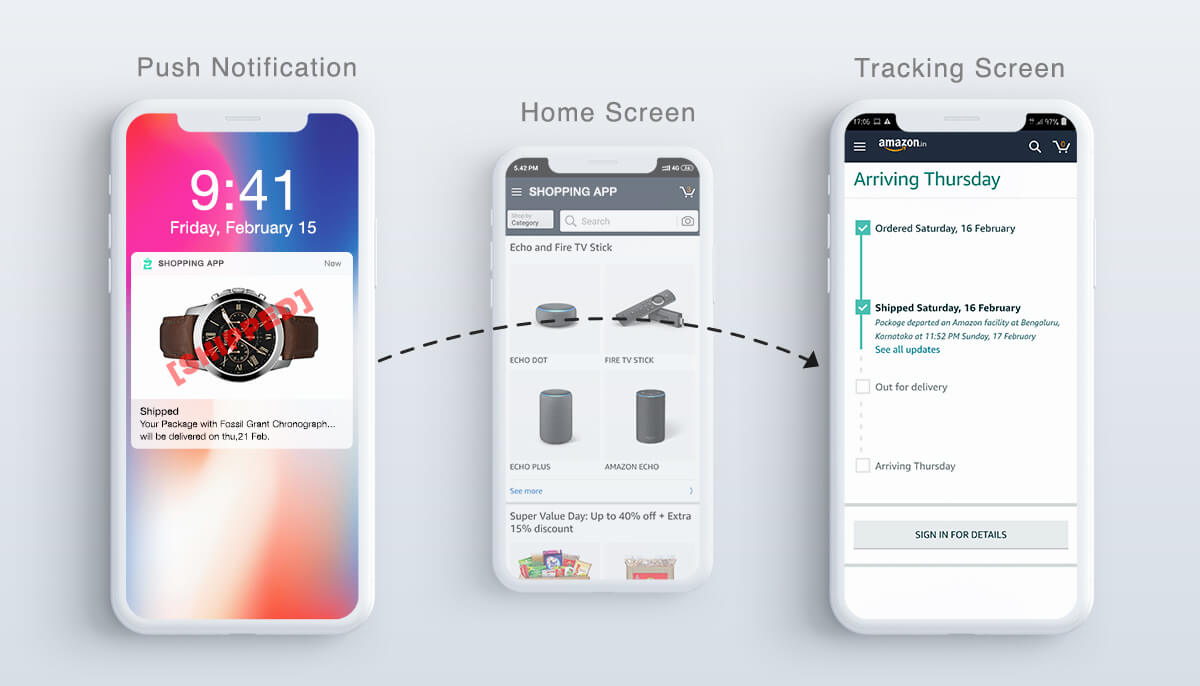
7. Improve discoverability through location-specific deep links
Embed location links in your geo-targeted push notifications. The users can directly locate a nearby store or restaurant when they receive such push notifications.
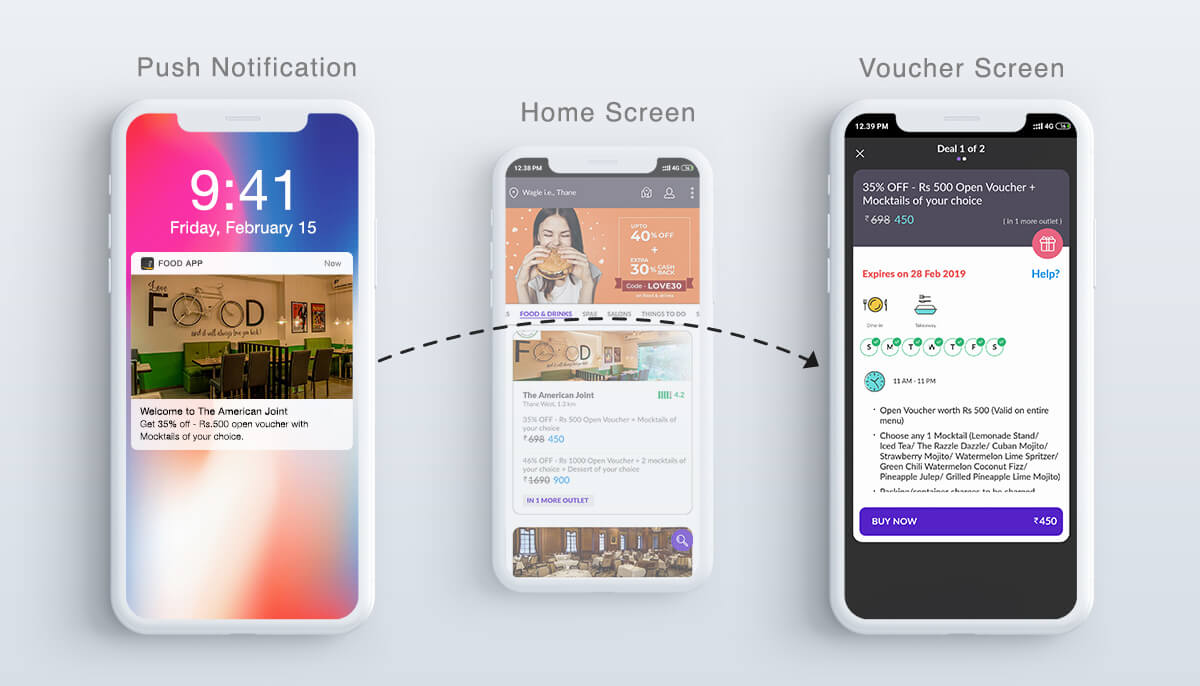
8. Personalize the app usage experience
Based on your users’ past behavior, send push notifications that take them to the content they like, products they may want to buy, share updates on the artists or content topics they are interested in, related products based on purchase history, a new message in their inbox, etc.
This adds an important dimension in personalizing the app experience for the user. Not only does this enhance the chances of conversion, but also drive up average in-app session lengths and long-term user retention rates.

Don’t Deep Link to Compete; Deep Link to Win!
Since the goal of deep linking is to enhance the app user experience, ensure that deep links take users directly to the content without requiring them to login or undertake intermediate steps.
The whole purpose of deep linking is defeated if you fail to plan how your deep linking structure will work in your app’s hierarchy, architecture, and logic.
Today, it is not enough for the apps to be fast, reliable, and secure to achieve business goals. Users expect and demand more personalized, hassle-free experiences.
Deep linking helps you deliver precisely that to your users consistently. Couple your deep linking strategy with your mobile marketing machinery to scale incredible growth in the long run!
To understand more about the latest trends and advancements in the mobile marketing world, talk to us today.







